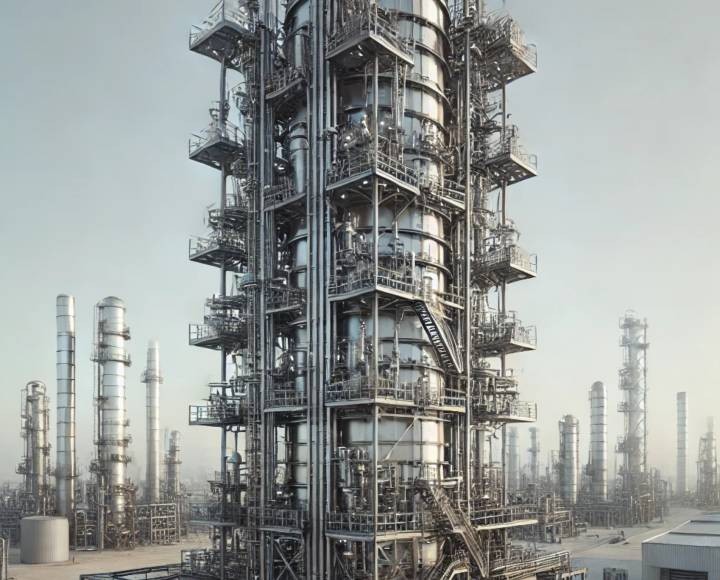A packed column, also known as a packed bed column, is a crucial component in many industrial applications, especially in chemical, petrochemical, and environmental industries. These columns are widely used for gas-liquid mass transfer operations, such as distillation, absorption, and extraction. The design of a packed bed column plays a vital role in optimizing mass transfer efficiency, reducing energy consumption, and ensuring operational stability.
In this article, we will explore the fundamental principles behind packed columns, detail the step-by-step process involved in their design, and discuss the factors that influence their performance. We will also examine the challenges faced during the design phase, optimization techniques, and the importance of maintenance and sustainability in the long term.
1. Fundamentals of Packed Columns
1.1 Basic Working Principle of a Packed Column
A packed column operates by allowing a gas phase and a liquid phase to flow countercurrently through the column, which is filled with packing material. The packing, which can be irregular or structured, provides a large surface area for the two phases to interact, facilitating efficient mass transfer, such as absorption, stripping, or distillation.
In a packed bed column, random packing material is typically used, meaning it is randomly placed within the column rather than in a specific, organized arrangement. Common packing materials include plastic, metal, and ceramic, each offering different advantages in terms of surface area, pressure drop, and chemical resistance.
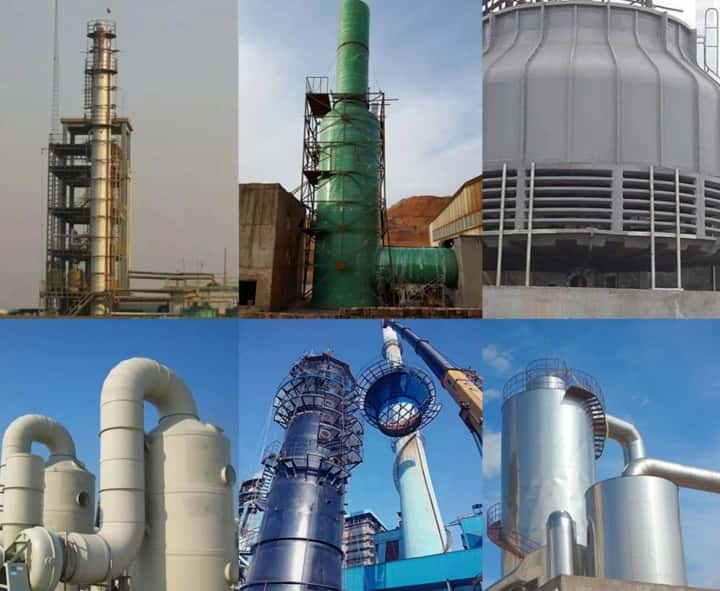
1.2 Types of Packing Materials
Selecting the appropriate packing material is critical to the design of a packed bed column. Common materials include:
- Plastic Packing: Materials like PVC and polypropylene are cost-effective, lightweight, and resistant to corrosion, making them suitable for less aggressive processes.
- Metal Packing: Stainless steel or other metal packings are often used in high-temperature or high-pressure applications due to their durability and strength.
- Ceramic Packing: Typically used for aggressive chemical processes or high-temperature applications where other materials might not perform effectively.
Each material has specific characteristics, such as surface area, porosity, and mechanical properties, which directly impact the column’s performance.
1.3 Gas-Liquid Flow Behavior in a Packed Bed Column
In a packed column, the gas and liquid phases move in opposite directions (countercurrent flow), which maximizes the contact between the phases and enhances mass transfer efficiency. The flow behavior of both phases—whether it is laminar or turbulent—plays a significant role in optimizing the design and ensuring effective operation.
1.4 Working Principle of Packed Towers
In a packed tower, the liquid enters from the top and is evenly distributed across the packing material by liquid distributors, flowing downward along the surface of the packing. The gas, on the other hand, enters from the bottom and is evenly spread by a gas distributor. As the gas moves upward, it flows countercurrent to the downward-moving liquid through the voids in the packing. This countercurrent contact between the gas and liquid phases facilitates mass transfer between the two.
The packed tower is a type of continuous contact equipment for gas-liquid mass transfer, where the two phases undergo continuous composition changes along the height of the tower. Under normal operating conditions, the gas phase is continuous, while the liquid phase is dispersed.
As the liquid flows down along the packing, it tends to move towards the tower wall, which can lead to an increase in liquid quantity near the wall. This is called "wall flow" and can result in non-uniform gas and liquid distribution. To mitigate this, liquid redistributors are placed at intervals in the tower when the packing layer is especially tall, ensuring even distribution.
1.5 Features of Packed Towers
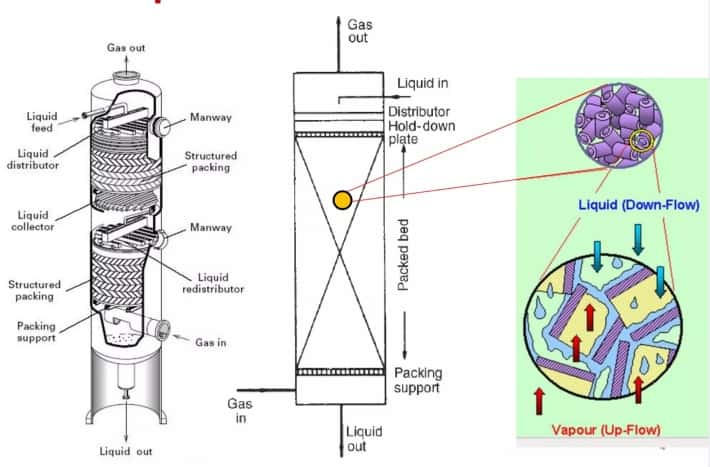
Higher Production Capacity: The working principle of packed towers differs from that of plate towers. In a plate tower, rising gas passes through a liquid layer to achieve mass transfer, with an open area of around 7% to 10% on each plate. In contrast, the open area in packed towers exceeds 50%, with a voidage greater than 90%. As a result, packed towers offer a significantly higher production capacity per unit sectional area compared to plate towers.
Better Separation Efficiency: Packed towers are known for their superior separation efficiency, especially under atmospheric or vacuum pressure conditions, where the filtration performance is much higher than that of plate towers.
Lower Pressure Drop: Due to the higher voidage in packed towers, the pressure drop is lower than in plate towers. Typically, the pressure drop in a plate tower ranges from 0.4 to 1.1 kPa per theoretical stage, whereas for packed towers, it is between 0.01 and 0.27 kPa. This lower pressure drop reduces both operating costs and energy consumption, making packed towers particularly well-suited for separating heat-sensitive materials.
Lower Liquid Hold-Up: Liquid hold-up refers to the quantity of liquid retained on the packing surface and other internals. The liquid hold-up in packed towers is typically less than 6%, compared to 8-12% in plate towers. While higher liquid hold-up can stabilize the tower structure and improve performance, it increases operating time, costs, and can negatively affect distillation processes.
High Operational Flexibility: Packed towers offer greater flexibility in operation, especially in terms of adapting to varying load conditions. The flexibility is primarily determined by the internal designs, particularly the liquid distributor. This high flexibility allows packed towers to be adjusted for different applications, unlike plate towers, whose operation is constrained by factors such as liquid flooding, entrainment, and downcomer capacity.
1.6 Advantages of Packed Columns
- Cost-Effective for Corrosive Liquids: Packed columns are generally more affordable than plate columns when handling corrosive liquids.
- Lower Liquid Hold-Up: Packed columns have a lower liquid hold-up compared to plate columns. This feature is important when minimizing the inventory of toxic or flammable liquids for safety reasons.
- Suitable for Foaming Systems: Packed columns are particularly effective for handling foaming systems, where other types of columns may face operational challenges.
- Lower Pressure Drop: Packing generally results in a lower pressure drop compared to plates, making it ideal for vacuum columns.
- Smaller Diameter Applications: Packed columns are particularly advantageous for smaller diameter applications (e.g., less than 0.6 m), where installing plates can be difficult and costly.
2. Components of a Packed Tower
A packed tower is an essential piece of equipment used in various industrial processes to enhance the mass transfer between gas and liquid phases. The following are the key components of a packed tower:
2.1 Tower Body
The tower body is the primary structure of the packed tower, typically cylindrical and constructed from steel. It is often coated internally to prevent corrosion and withstand harsh operating environments.
2.2 Tower Packings
Tower packings are materials placed inside the tower to facilitate the interaction between the liquid absorbent and the gas stream. There are two main types of packings:
- Structured Packings: These have an organized geometric pattern designed for high efficiency.
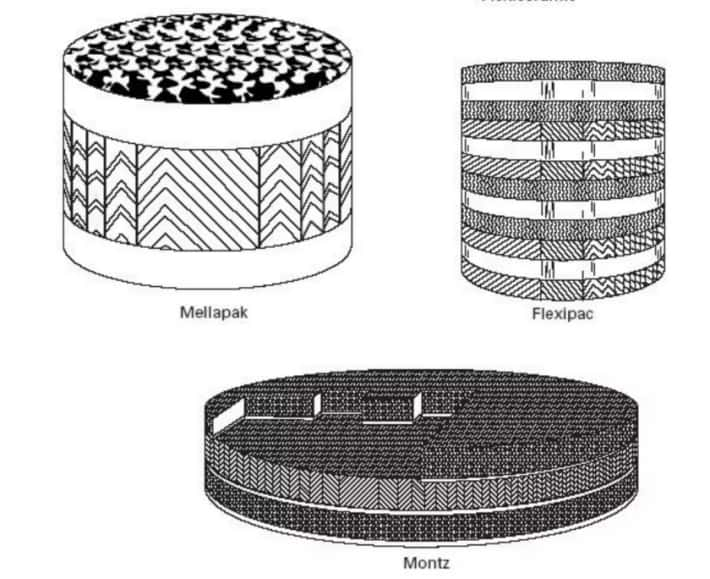
- Random Packings: Irregularly shaped materials that provide flexibility and are often used in less demanding applications.
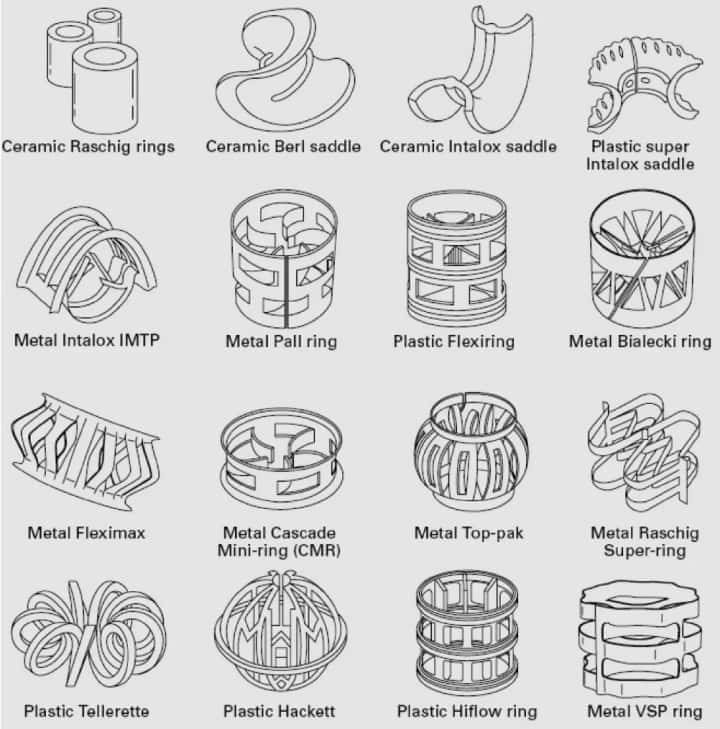
2.3 Demister Pads
Demister pads are used to capture and remove moisture droplets from the exiting gas stream, preventing the loss of liquid absorbent and ensuring dry gas exits the tower.
2.4 Tower Internals
These components support and optimize the operation of the tower:
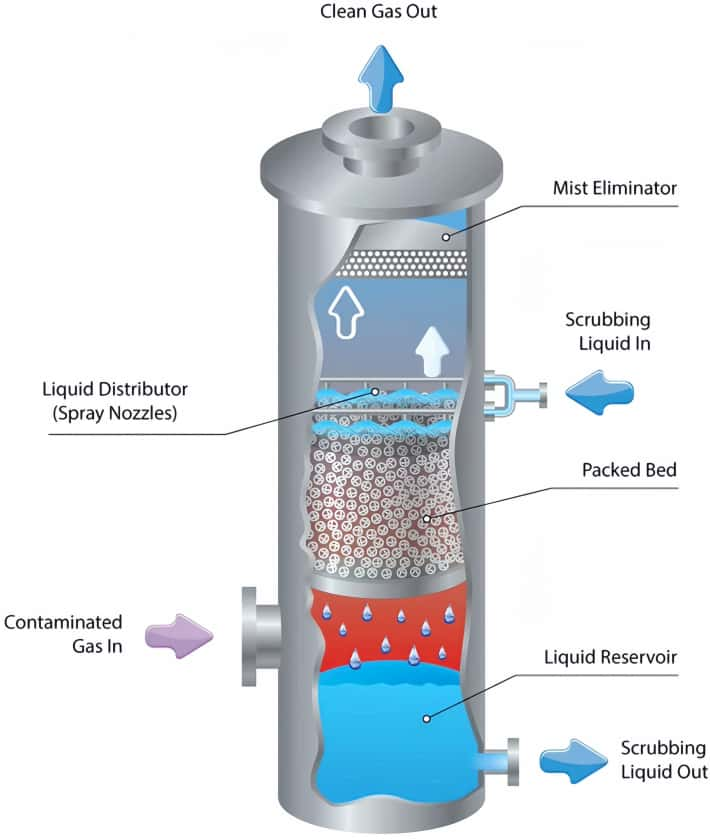
- Liquid Distributor: Ensures the even distribution of liquid absorbent over the packing surface.
- Packing Supporting Grid: Holds the packing materials in place and allows liquid to drain away.
- Packing Hold-Down Grid: Prevents the packing from shifting under operational pressures.
- Liquid Redistributor: Redistributes liquid at various levels in the tower to maintain consistent coverage of the packing.
- Gas Distributor: Ensures that the incoming gas is evenly distributed across the tower’s cross-section, allowing for effective interaction with the liquid.
2.5 Spray Distribution System
The spray distribution system is responsible for evenly spreading the liquid absorbent across the top of the packing to maximize contact with the gas stream.
2.6 Reservoir
Located at the base of the tower, the reservoir serves as the wet well for the pump, collecting the liquid absorbent that drains from the packing.
2.7 Pump
The pump is responsible for transferring the liquid absorbent from the reservoir to the spray distribution system, ensuring continuous flow through the tower.
2.8 Blower
The blower forces the gas stream upward through the packing materials, ensuring that the gas and liquid phases interact effectively.
2.9 Support Floor
The support floor is a crucial structural element that supports the packing, allows liquid to drain from the packing, and assists in the even distribution of gas. It also creates space for the gas to spread across the tower’s cross-section before entering the packing.
3. Steps in Designing a Packed Column
Designing a packed column involves a systematic process, from defining the operating conditions to selecting the appropriate packing material and performing detailed calculations. Each step must be carefully executed to ensure that the column operates efficiently and meets the required separation or absorption specifications.
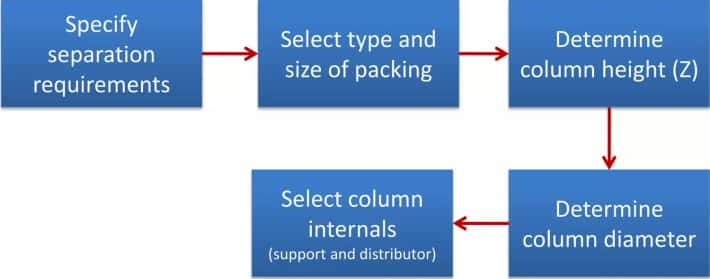
3.1 Preliminary Design of a Packed Bed Column
The preliminary design phase involves defining the basic operating parameters, such as the flow rates of the gas and liquid phases, temperature, pressure, and the desired separation efficiency. These parameters determine the size of the column and the type of packing material needed. Engineers must select a packing material that balances mass transfer efficiency with pressure drop and cost-effectiveness.
3.2 Calculation and Modeling for Packed Column Design
Once the initial parameters are set, engineers must perform detailed calculations and simulations to fine-tune the design. Key calculations for a packed bed column include:
- Mass Transfer Efficiency: Determining the mass transfer coefficient, which depends on factors like fluid flow rates, packing characteristics, and the interaction between phases.
- Pressure Drop Calculations: The pressure drop in a packed column affects operational efficiency and energy consumption. An excessive pressure drop can lead to higher pumping costs and decreased column performance.
- Column Sizing: The height and diameter of the column must be determined based on the required throughput, efficiency, and pressure drop constraints.
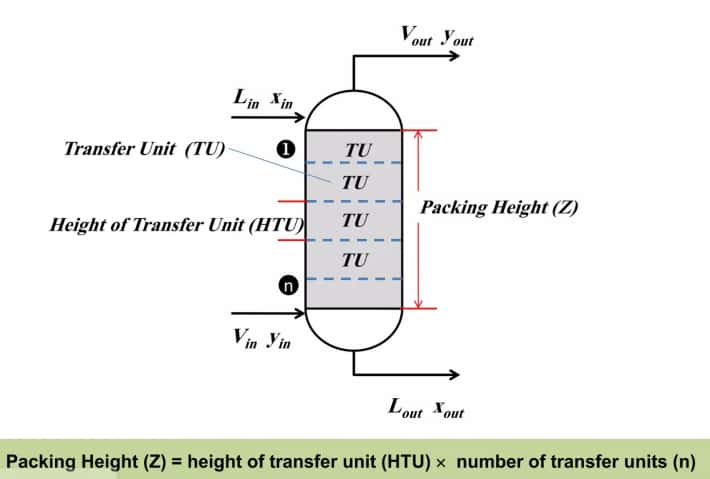
- (from:https://www.slideshare.net/slideshow/design-of-packed-columns/44960926)
3.3 Equipment Selection and Layout for Packed Bed Column
After performing the necessary calculations, engineers must select the appropriate distributors, collectors, and packing supports for the column. Properly designed distributors ensure that the liquid phase is evenly distributed over the packing, which is critical for maintaining high mass transfer efficiency. The column layout should minimize resistance to flow and ensure that the gas and liquid phases have optimal contact.
4. Factors Influencing the Design of a Packed Column
Several factors must be considered during the design of a packed bed column to optimize its performance and ensure efficient operation.
4.1 Fluid Properties
The physical properties of the fluids, such as viscosity, density, surface tension, and diffusivity, influence the behavior of the phases within the packed column. For instance, a higher viscosity liquid will have a thicker liquid film on the packing, which can reduce the mass transfer rate. Similarly, the diffusivity of the gas phase determines how quickly the gas molecules interact with the liquid phase.
4.2 Operating Conditions
The specific operating conditions—such as flow rates, temperature, and pressure—are critical to ensuring optimal performance in a packed column. For example, in a packed bed column, higher flow rates might increase mass transfer but also lead to greater pressure drops. The column must be designed to operate within a specific range of conditions for maximum efficiency.
4.3 Mass Transfer and Heat Exchange
In a packed bed column, mass transfer is the primary goal, and the efficiency of this process is highly dependent on the packing material and column design. Heat exchange within the column can also affect performance, especially in processes that involve temperature-sensitive reactions, such as distillation.
4.4 Hydraulics of the Packed Column
Hydraulic considerations, including the liquid hold-up, flow distribution, and pressure drop, are critical for optimizing the column's performance. Uneven liquid distribution or excessive pressure drop can reduce the efficiency of the packed bed column, leading to higher operational costs.
5. Packing Material Selection and Optimization
The selection of packing material is a key design decision that can significantly impact the performance of the packed column. Several factors must be considered when choosing packing material, including surface area, porosity, mechanical strength, and chemical compatibility.
5.1 Material Selection
Common materials used in packed bed columns include plastics (e.g., PVC, polypropylene), metals (e.g., stainless steel), and ceramics. The choice of material depends on the specific application and the chemical and physical properties of the fluids involved.
5.2 Surface Area and Porosity of the Packing
The surface area and porosity of the packing material determine the mass transfer efficiency of the packed column. Higher surface area and void fraction provide more contact points for gas-liquid interactions, but they may also increase the pressure drop across the column.
5.3 Pressure Drop and Efficiency in Packed Bed Columns
While selecting packing, a balance must be struck between mass transfer efficiency and pressure drop. An overly high pressure drop can lead to increased energy consumption and operational costs, while a lower pressure drop might compromise the mass transfer performance of the packed bed column.
6. Dynamic Operation and Control of Packed Columns
6.1 Operational Stability in Packed Bed Columns
Ensuring the stability of a packed column during dynamic operation is critical to achieving consistent performance. Fluctuations in flow rates or feed composition can affect the mass transfer efficiency. Therefore, real-time monitoring and control systems are essential for optimizing column operation.
6.2 Control Systems for Packed Columns
Advanced control systems are often implemented in packed columns to automatically adjust parameters like flow rates, temperature, and pressure. These systems ensure that the column operates efficiently under varying conditions and help to prevent issues like flooding or dry-out, which can disrupt the mass transfer process.
6.3 Flexibility and Adaptability in Operation
A well-designed packed bed column should have the flexibility to adapt to different operating conditions, including changes in feed composition, flow rates, and product requirements. This flexibility helps to maintain high operational efficiency and reduces downtime.
7. Design Challenges in Packed Columns
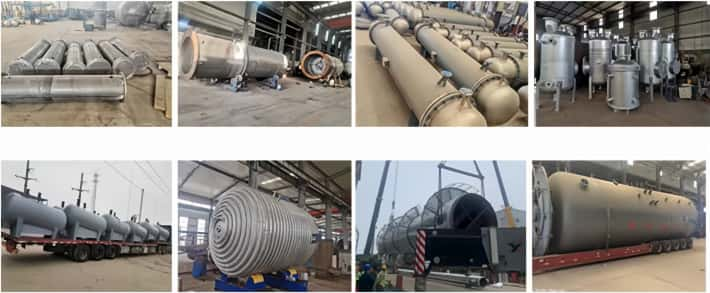
7.1 Packing Blockage and Wear
Packing materials in packed columns can experience wear or blockage over time, especially if the feedstock contains particulates or if the liquid distribution is uneven. Proper maintenance and regular inspection are essential to prevent these issues from affecting performance.
7.2 High Pressure Drop
An excessive pressure drop across the packed column can reduce efficiency and increase operational costs. Designers must carefully select packing materials and column dimensions to ensure that the pressure drop remains within acceptable limits.
7.3 Liquid Distribution Issues
Proper liquid distribution is crucial for ensuring that the liquid phase interacts effectively with the gas phase in the packed bed column. Maldistribution can lead to poor mass transfer, reduced efficiency, and operational problems.
8. Simulation and Modeling of Packed Columns
8.1 CFD Simulation for Packed Bed Columns
Computational Fluid Dynamics (CFD) simulations are increasingly used to model the flow patterns, mass transfer, and pressure drop in packed columns. CFD tools help engineers visualize the behavior of fluids within the column and identify areas for improvement.
8.2 Multi-Physics Simulations
For complex processes, multi-physics simulations that combine fluid dynamics, heat transfer, and chemical reactions can provide a comprehensive understanding of packed column behavior. These simulations allow engineers to optimize the column design for different operating conditions.
9. Economic and Sustainability Considerations
9.1 Life-Cycle Cost Analysis
Performing a life-cycle cost (LCC) analysis helps assess the total cost of a packed bed column over its entire operational life, including initial investment, operational costs, and maintenance. This analysis helps identify the most cost-effective design and material options.
9.2 Energy Efficiency in Packed Columns
Optimizing energy consumption is critical, especially for large-scale operations. Minimizing pressure drop, improving heat integration, and reducing pumping costs can significantly enhance the energy efficiency of packed bed columns.
9.3 Sustainability and Environmental Impact
Sustainability is an important consideration in the design of packed columns. Using eco-friendly materials, improving energy efficiency, and designing for longer operational lifespans can help reduce the environmental footprint of these systems.
10. Maintenance and Operational Longevity of Packed Bed Columns
10.1 Regular Maintenance of Packed Columns
Regular maintenance, including packing replacement and cleaning, is essential for ensuring the long-term performance of a packed column. Periodic inspection helps to prevent issues like fouling and ensures the column continues to operate efficiently.
10.2 Optimizing Long-Term Performance
Monitoring the column's performance over time is crucial to identify signs of wear, reduced separation efficiency, or pressure drop increases. Regular maintenance schedules help prevent costly downtime and extend the operational life of the packed bed column.
11. Conclusion
Designing an efficient packed column or packed bed column requires a thorough understanding of mass transfer principles, fluid dynamics, and material selection. By considering factors like fluid properties, packing material, operating conditions, and control strategies, engineers can design columns that operate efficiently and sustainably. As computational tools and simulation techniques continue to advance, the design and operation of packed columns will become even more optimized, cost-effective, and environmentally friendly.
